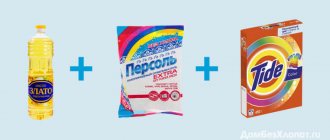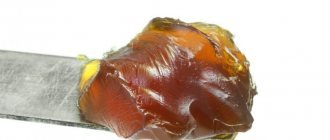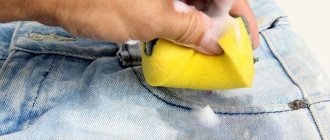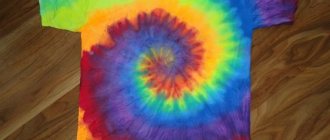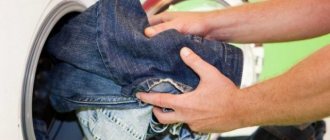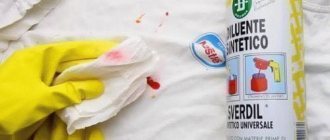While doing creative work, a small child may accidentally stain his or her parents' clothes or things with paint. Artists also often have the problem of old stains that are difficult to remove, especially from white fabrics. To understand how to remove watercolor paints from clothes, you first need to determine the degree of soiling, the type of fabric and suitable cleaning products.
Features of removing watercolor paints
Watercolor paints are water-based and contain various ingredients that help the paints to be absorbed into the fibers of the material. In particular these are:
- dye powder;
- natural adhesives for binding other components;
- a plasticizer to soften the composition, usually honey, glycerin or sugar;
- ox bile – prevents watercolor paint from curling;
- phenol – protects against mold and mildew;
- water as a solvent.
Thanks to the properties of most components, watercolor paint stains are easy to clean, especially if they are fresh.
How to remove a fresh stain
Since watercolor paints are water-based, you can remove fresh stains without much effort. For this:
- Turn the item inside out.
- Place the contaminated area under running cold water.
- Apply soap suds to the mark and rub with your hands.
- Rinse off any remaining substances with water.
As a rule, such efforts are enough to remove watercolors from fabric.
How to remove watercolor stains using specialized products
Specialized products can remove watercolor stains. They are convenient because they are easy to use, widespread and available in any price category. Purchased methods cope with both fresh and old blots, and are also suitable for almost all fabrics. As a rule, stains can be removed the first time.
To restore soiled items, you can use the following purchased products:
- A good baby powder, such as Eared Nanny, works great on specific stains. In addition, the product is hypoallergenic. To remove watercolor paints, wash the product twice in a washing machine using baby powder. As a rule, after this the contamination disappears.
- Stain removers (Vanish, Amway and others) remove stubborn stains. In 20 minutes, the product can remove watercolor blots from the product. To do this, apply the stain remover to the stained area, let it soak in and wash it off. Use the chemical according to the instructions. At the same time, you should pay attention to the features of washing the product. You can usually see them on the label.
- Laundry soap only removes fresh stains. Therefore, when contamination appears, immediately soap the stained area, let it soak for 5-10 minutes, rinse under running cold water, and wash the product in the usual way. Experts recommend using soap with a high fatty acid content of 72%.
- Dishwashing liquid can remove fresh watercolor stains from clothes. “Fairy” does a particularly good job. A small amount of product is applied to the contaminated area and lathered thoroughly. It is convenient to carry out the procedure using an old toothbrush. After 5 minutes, wash the clothes in the usual way.
- Laundry capsule (“Tide” or “Ariel”) is an improved method that can cope with any dirt. If the stain is old, then pre-treatment is carried out before washing. The soiled clothes and product are placed in the washing machine. Then start the wash as usual.
Methods for removing watercolors from clothes
If more than an hour has passed since watercolor got on your clothes, simply washing in cold water will not help. In this case, you will have to resort to more effective methods.
How to wash
You will only get the effect of processing the product by following certain recommendations:
- For best results, pre-wash the item;
- choose only the processing mode suitable for the type of fabric;
- Scrape off dried paint with a sharp object.
Use improvised or store-bought chemicals to clean stains, following the indicated rules.
Please note that when washing fresh watercolor stains, it is extremely important to use only cold water, otherwise under the influence of high temperatures, the watercolor will be even more absorbed into the fibers of the material.
Features of washing children's clothes
High-quality children's powder copes well with traces of watercolor paints. Using a detergent for washing children's clothes, you definitely will not worry about allergic reactions on your child's skin. To completely remove stains, wash the product 2 times and it will disappear.
Preparing things
If you start removing stains immediately after contamination, the chance of complete cleaning increases. Once the paint has hit the fabric, you need to:
- turn the product inside out;
- rinse it under water until the stain begins to disappear;
- Wipe the blot with laundry soap and wash the item by hand;
- Rinse the product under running water.
Note! The temperature should not be high, since in hot water the paint eats into the fibers of the fabric more strongly. You only need to turn on cold water.
Traditional methods
To remove a watercolor stain from clothing, you don’t have to run to the hardware store for an expensive stain remover. You can wipe away traces of watercolor paint using available substances.
Oil and powder
If the stain is still fresh, clean the item using washing powder mixed with oil. Rub the resulting paste into the stain with a brush. Rinse the treated area thoroughly and wash the item.
Ammonia with salt
Ammonia copes well with various types of stains, including watercolor marks. For the procedure, in addition to ammonia, you will need a saline solution prepared from 1 teaspoon of salt and 1 liter of water. Soak the stain with ammonia and leave for 5 minutes. After this, place the item in salt water and wait another 20 minutes. Remove the item, place it in the washing machine and wash as usual.
Laundry soap
Wet the paint stain with cold water and soap it with laundry soap. Leave the product on the stain for 2-3 hours, regularly moisturizing the soaped area. Rinse off the remaining soap with cold water, and then put the item in the wash.
Soap and soda
The method is suitable for removing stains from cotton materials. Dissolve 1 teaspoon of baking soda and a little shavings of laundry soap in 1 liter of water. Pour the solution into an enamel container and boil. Turn off the heat and place the product in hot water for 10-15 seconds. Extract and look at the result. Repeat the procedure until you achieve the desired effect.
Glycerol
Glycerin not only removes various contaminants, but also softens the fibers, so the method is suitable for cleaning even delicate items. Melt the glycerin in a water bath or in the microwave and apply to the mark. It is more convenient to use a cotton sponge or cloth for this purpose. Leave the glycerin on the surface of the material for 15 minutes and then wash the product.
To prevent glycerin from leaving a greasy stain on the fabric, first mix it with ammonia in a 1:1 ratio.
Hydrogen peroxide and soda
When mixed, the substances form an excellent remedy for combating watercolor stains. Mix baking soda and hydrogen peroxide in equal proportions and add a little hot water. Apply the cleaning mixture to the problem area and leave for 20 minutes to work. Afterwards, rinse off the remaining substances with cold water and wash the item of clothing.
Vinegar
The method is suitable for processing any materials except delicate ones. Before the procedure, warm up some vinegar in the microwave or on the stove. Moisten the stain with hot product and leave for 5 minutes to act. After this, rinse the area with cold water and then wash as usual.
Removing old stains
You can stop throwing away good things; to do this, it’s enough to figure out how to wash watercolors that have become deeply ingrained into the fabric. If the stain is old, then this is not a reason to throw away the item - you can use special methods for working with complex stains.
There are several ways:
- You need to wet the cloth under cold water, treat it with soap and leave for a couple of hours.
- The stain remover is specially designed to remove difficult stains. It can be used if the fabric allows.
- Soda and peroxide are mixed in a proportion of 20 g per 20 ml, then 20 ml of water is added. Apply the resulting paste to the area of contamination and leave for a couple of hours.
- The stain should be treated with glycerin and the product should be set aside for a quarter of an hour. After this, alcohol and glycerin are mixed in equal proportions, and the resulting mixture is rubbed into the blot.
Advice. Fresh stains are easier to remove from clothes, so don’t hesitate to wash them.
Use of household chemicals
If you have stain removers or other household chemicals in your arsenal, try using them to remove watercolor stains.
Baby washing powder
Washing powder for children's clothes can be used to treat not only the child's clothes, but also other textiles stained with watercolors. The substances included in the powder actively affect the components of the paints, breaking them down into smaller substances, due to which the paints are successfully removed from the material. Since there are no aggressive substances in the baby powder, watercolor stains on certain fabrics are not removed immediately, but only the second time, so for the best result, repeated washing will be required.
Dishwashing liquid
Suitable for removing fresh stains from clothes. Apply some dishwashing liquid to the stained area and rub in with a sponge or toothbrush. Leave the substance to act for 5-7 minutes and then rinse with water. After such treatment, it is better to wash the product by hand or in a washing machine.
Oxygen stain remover
In the assortment of household chemicals you will find many stain removers that remove watercolor stains well, do not harm the main dye of the fibers and are suitable for processing delicate fabrics.
Amway SA8
It is used both for pre-soaking and for strengthening regular washing powder during washing. Active oxygen components penetrate deep layers of fibers and break down paint pigments. Amway SA8 powder is suitable for almost any material except delicate ones such as wool or silk.
Stork Stop Spot
It is used mainly for washing children's clothing in light shades, but it does a good job of removing stains on other materials. Rub the Stork Stop Spot soap onto the problem area and rinse off with cold water after 20 minutes.
Vanish
This popular stain remover helps clean stains on white and colored clothing. It is produced in the form of a liquid that actively affects various types of contaminants. The instructions on the package will help you determine the optimal processing method and the required amount of product.
"Antipyatin"
Solid soap designed to remove stains does an excellent job of removing watercolor marks on materials. Rub the area previously moistened with cold water with soap and leave for an hour to act. Rinse off the substance with running cold water and completely wash the item by hand or in a machine. If you don’t have the product at hand, replace it with regular laundry soap.
How to remove stains from a white shirt or blouse
If watercolor stains remain on a white blouse or shirt, use more effective treatment methods.
Vinegar and ammonia
The substances enhance each other’s actions, so they work well in removing stains on white clothes. Mix ammonia and vinegar in equal proportions, and soak a cotton swab in the resulting solution. Gently rub the stain from the edges to the center, and then be sure to wash the product.
Boiling
The method is only suitable for removing stains on cotton and linen clothes. For the procedure you will need:
- 1 liter of water;
- laundry soap shavings;
- 1 tbsp. spoon of soda ash;
- 1 teaspoon of ammonia;
- 1 teaspoon of hydrogen peroxide.
Mix the substances in an enamel container and put on fire. Place the product with stains of watercolor paints into the container and boil over low heat for 40 minutes. Carefully remove the item of clothing from the container with tongs and wash with powder or simply rinse thoroughly in plenty of water using conditioner.
Use of solvent
Such products should be used as a last resort and only on suitable materials, but in no case delicate ones. You can use:
- refined gasoline;
- kerosene;
- turpentine;
- solvent for oil paints.
Before the procedure, be sure to check how the substance affects the tissue in an inconspicuous area. If everything is fine, lay the product on a horizontal surface, soak a cloth in the selected substance and rub the stain. Continue rubbing until the mark disappears. After treatment, be sure to wash the item of clothing as usual.
How to remove old watercolor stains
If watercolor paint has dried on the surface and cannot be removed using simple methods, you should resort to more drastic processing methods.
Dry fragments
This method is suitable for removing stains from dense materials. It’s better not to rush here, but rather wait until the trail dries. Scrape dry watercolor from the surface with a sharp object, such as the blade of scissors or the back of a knife.
Hot salt solution for stains
The method is not suitable for processing synthetic and delicate materials. Dissolve a handful of salt in hot water and keep the product in the solution until the water cools. Afterwards, be sure to wash the item in the usual way.
Toothpaste
Regular toothpaste removes stains from white materials well. Apply some paste to the watercolor mark and scrub with an old toothbrush for a few minutes. After processing, wash the product.
White Spirit
The substance is able to remove even stubborn stains of hair dye, so cleaning the material from watercolors will not be difficult. The product is aggressive, so before use, check whether it will damage the fibers by moistening an inconspicuous area of the material with White alcohol. If nothing happens to the treated area, feel free to wipe the dirt on the product with the substance.
Dry cleaning
Contact a professional dry cleaning service if none of the suggested remedies help. Watercolor stains are considered not very durable, so experts can handle them without much effort.
Features of removing stains from different materials
Of course, each method indicated should be used only in accordance with the type of material from which the soiled item is sewn.
Cotton
Cotton is the easiest material to remove watercolor stains from. To begin with, try more friendly substances, for example, laundry soap, industrial products or hot vinegar. For white items, you can use a more radical method - boiling.
Natural silk
Delicate material that requires special treatment. To remove stains from silk, you can safely use laundry soap, leaving the foam on the problem area for 20 minutes, as well as denatured alcohol. Preheat the alcohol in a water bath. Soak a sponge in the substance and gently wipe the stain from the edges to the center. After drying, sprinkle the treated area with talcum powder without impurities and oils.
Synthetics
Under no circumstances should synthetics be boiled or even washed in hot water. For processing, use only cool water. Traces of watercolor paint can be easily removed from synthetic materials using ammonia and soaking the product in a salt solution.
Wool
Such a delicate material as wool does not tolerate exposure to aggressive substances. The best product for processing wool products is laundry soap. To keep the fibers soft, use soap suds and cold boiled water for cleaning.
Knitwear
Use eucalyptus oil to remove paint stains from knitted fabrics. Moisten a cotton swab with ether and carefully wipe the mark from the edges to the center. Greasy stains can be cleaned with acetone or alcohol. After processing, place the product in the washing machine.
Jeans
You can remove watercolor paint from thick denim by scraping the surface with the back of a knife. To remove fresh traces of watercolor, laundry soap or stain remover is perfect.
How to remove fresh stains
If you notice traces of watercolor paint on a dress or shirt, you should proceed as follows:
- Turn the affected product inside out.
- Place the stained area under running cool water and hold for several minutes until the stain fades.
- Treat the contaminated area of fabric with laundry soap and rub the stain with your hands.
- Rinse the product in cool water.
IMPORTANT! DO NOT USE HOT WATER TO CLEAN ART PAINT STAINS. UNDER INFLUENCE OF HIGH TEMPERATURES, THE NATURAL DYE PIGMENT IS ONLY MORE EMBRACED INTO THE FABRIC.
Usually these measures are quite enough to eliminate fresh stains from watercolor paint. If the result leaves much to be desired, the procedure can be repeated.
How to remove traces of face painting?
Aquagyrm is very similar in composition to watercolor paints, therefore it is removed from materials in the same way as watercolor marks. To remove face painting stains, use laundry soap, rubbing the contaminated area with the substance and rinsing with cold water after 20–25 minutes. If the pigment has penetrated into the deep layers of the fibers, use a stain remover or glycerin with ammonia to clean.
Washing watercolor paints is not difficult if you follow certain processing methods depending on the age of the stains and the type of material. To begin with, try treating the product with gentle means at hand, and resort to more aggressive substances or dry cleaning only in extreme cases.
How to clean white fabric
If watercolor stains cannot be removed, then embroidery will help solve the problem.
White school aprons, blouses and shirts more often than other things suffer from careless handling of watercolor paints. You can remove colorful stains from light-colored fabric as follows:
- Combine 100 ml of water, 100 ml of hydrogen peroxide and 100 g of tea soda.
- Soak the contaminated area of the material in this solution for 30 minutes.
- Wash the product with washing powder.
If clothes made of thick cotton fabric are damaged, you can cope with the situation by boiling. Water is poured into the laundry tank, grated laundry soap is added, clothes are immersed and boiled for an hour.
It is very rare, but it still happens that traces of watercolor paint cannot be removed using any of the listed methods. If children's clothing is damaged, you can solve the problem using embroidery or appliqué.
To avoid having to waste time and effort on removing stains and restoring the appearance of clothes, it is better to paint while wearing an apron and special sleeves.


